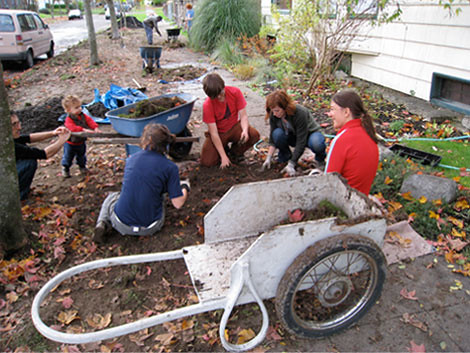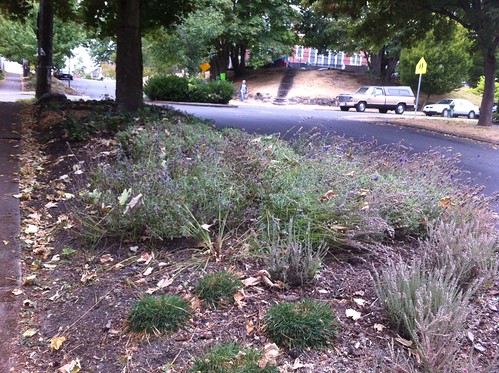
UPDATE: She’s a Genius!
With the help of a small army of volunteers and a network of property owners, Sarah Bergman has been building what could be the city’s largest art project right in the middle of the Central District: The Columbia Street Pollinator Pathway, which stretches one mile from Seattle University to Nora’s Woods in Madrona.
Now in its fourth year, arts organizations from the Seattle Art Museum to the Stranger’s Genius Awards are lining up to praise Bergman’s inspiring work: A community-building, ecologically-interesting and visually-appealing corridor of gardens that appeal to Seattle’s native pollinators and connect two urban green spaces. She has been named the 2012 recipient of the Seattle Art Museum’s Betty Bowen Award and is also nominated for a Genius Award from the Stranger (winner will be announced Saturday).
For each section of the pathway, Bergman meets with property owners along Columbia Street and tells them about the project. She then has them sign an agreement saying they will help maintain the gardens that Bergman and a team of volunteers will help plant.
She has a list of local pollinator friendly plants that have been approved by the city to ensure they don’t block sight lines along the street. As she learns more about local pollinators, she updates her list to include more plants to better suit their various needs.
“Butterflies need a nectar plant and a host plant for laying eggs,” said Bergman explaining her process and how she chooses which combination of plants to choose. “We want to know more about what pollinators are there so we can plant everything they need.” To meet this end, researchers are studying the project area to document all the pollinators present and to see if the project increases their numbers and diversity.
A common misconception is that the project is all about bees. In fact, the sometimes aggressive European honeybees are, as the name suggests, not native. However, there is an ever-growing list of 800-1,000 pollinators that are native, including butterflies, humming birds, small mammals, bats and native bees. Bergman, who happens to have a bee allergy, says the focus is on these native pollinators as a solution to our nation’s pollination problems (and not solely an attempt to fix the collapsing honeybee population crisis that has struck the nation in recent years).
Columbia Street property owners who are interested in getting involved can get in touch. The Pollinator Pathway team can provide the materials and the work to get it going, you just have to agree to let them plant in your parking strip and agree to water weekly and do light maintenance. Obviously, this means they also need volunteers for their weekly work parties (Saturdays from 12:15-3 p.m.).
They also have a big two-day Camas Planting work party next week. Details:
We’re having a big Camas Planting in less than two weeks, and installing two new gardens- come join us! It will be really fun. Camas is an amazing bulb that makes a beautiful purple flower in spring. We’re planting about 400 bulbs- its going to be amazing! Come on out- we will be roving a bit, but always on Columbia, and starting at 15th and Columbia.
Dates: Sept 29 and 30, 11-4.
Day 1: start at 15th and Columbia. Day 2, start at MLK and Columbia.


It’s been a kick to see the flash mob planting sessions along columbia.
CD News had posted earlier on the idea of a bicycle greenway on Columbia- maybe a greenway in more ways than one? if the two ideas jibed, that would be a pretty unique drag.
We don’t park on them :) or at least we’re not supposed to (generally speaking it’s not legal). They’re strips for plants, and the work Sarah started and continues to do is wonderful. Let’s think of them as planting strips instead.
Sarah used to be our next door neighbor and I was excited to see her get started on this effort. Way to go!!! I have noticed more varieties of bees in our yard in the last couple of years…it would be interesting for someone to study the ‘before’ and ‘after’ effects of this type of pathway.
What a fantastic project, and one that can hopefully be replicated in other areas of town and other cities as well. I’m so glad that Sarah shares some of the planting maps – I want to put pollinator-friendly gardens in my planting strip too.